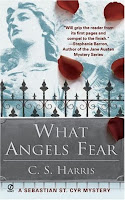The Regency period (1811-1820) is a rich environment for setting mysteries. Although staunchly defended by aristocrats and politicians, the British monarchy is vulnerable. Mad King George III is deemed unfit to rule. The Prince of Wales (King George IV when his father dies in 1820) rules the empire – at least on paper. The American colonies have revolted; the French sent crowned heads rolling. The Napoleonic Wars drag on at great expense, creating a fog of intrigue.
Along the way he adopts a crafty, 10-year-old pickpocket, Tom, and reignites his passion for Kat Boleyn, a beautiful actress who rejected his marriage proposal and abandoned him years earlier. He briefly kidnaps Lord Jarvis’ unflappable daughter, Hero, with whom he has a unexpectedly complex relationship in future books.
Equally appealing is Sebastian’s friend and assistant Paul Gibson, a surgeon he met during nightmarish years in the Army. Paul’s lower leg was blown off by a cannonball, ending his time in the army and leaving him fighting an opium addiction. He lives in the shadow of the Tower of London, providing free clinical care, teaching and doing autopsies.
In addition to the mysteries solved in each book, there is an overarching mystery about Sebastian’s origins, his parents’ relationship, whether he can overcome the barriers that prevent him from marrying Kat, and how he will be able to meet the expectation that he produce a suitable heir to carry on the legacy of the St. Cyr family. C.S. Harris’ pacing as she reveals information about these overarching mysteries is exquisite and makes the series addictive.
Sebastian St. Cyr mysteries in order
- What Angels Fear, takes place in 1811 as the Prince of Wales becomes the Prince Regent taking power from his father, mad King George III. A beautiful, ambitious young actress Rachel York is found brutally murdered and raped on the steps of a chapel altar in a parish church near Westminster Abbey. An unusual dueling pistol points suspicion toward Sebastian St. Cyr, Viscount Devlin. As he runs for his life, he realizes his only hope is to find the killer himself.
- When Gods Die, takes place in June 1811, when the aristocracy has gathered at the Royal Pavilion in Brighton. The Prince Regent, responding to what he takes as an advance from a beautiful young woman married to a shockingly old lord, finds the woman on a couch in an empty room – with a jeweled dagger that once belonged to Bonnie Prince Charlie sticking out of her back. As the prince’s doctor and advisors scramble to clear him from responsibility for the death, people on the street gossip about whether the House of Hanover is cursed with madness. Sebastian is invited to investigate because, as a member of the aristocracy, he can explore the issues without giving offense or ignoring the larger issues of the monarchy’s security. The assignment has no appeal to him until he realizes that he last saw the odd bluestone and silver necklace the dead lady wore on his mother’s neck just before she boarded a ship that sank in the channel during a storm.
- Why Mermaids Sing, (London, September 1811), a series of grisly murders of young aristocrats threatens the early months of the Regency. Their corpses are dumped in public places with strange objects inserted in their mouths Local magistrate Sir Henry Lovejoy turns to Sebastian for help as all are sons of highly placed aristocrats. Sebastian finds the fathers oddly uncooperative. Nothing seems to connect until Sebastian finds clues pointing to an infamous ship, mutiny and the near deaths of a group of passengers. One casualty of the incident was David, son of Charles, Lord Jarvis, the Prince Regent’s cousin and the power behind the throne. Even as Sebastian hurries to halt the murders, his personal life is in tumult, and devastating secrets about his father’s past have tragic consequences for his relationship with Kat Boleyn.
- Where Serpents Sleep (London, 1812). Hero Jarvis, daughter of Lord Jarvis, becomes the only survivor – and witness – to the slaughter of eight young prostitutes in a Quaker house of refuge. Hero asks Sebastian to investigate because one of the victims was a well-born lady who inexplicably ended up on the streets. Fiercely independent and actively involved in the investigation, Hero herself becomes the target of killers even as her father seeks to shut-down the investigation to protect her reputation.
- What Remains of Heaven (London, 1812). The violent death of a controversial, reform-minded Bishop of London leads Sebastian from back alley slums to the halls of power as he investigates and finds himself confronting well-guarded secrets of his own family’s past.
- Where Shadows Dance (July 1812). Paul Gibson, a surgeon and Sebastian’s long-time friend, buys the cadaver of a young man illegally. The dead man, reported to have died of a weak heart, is a rising star at the Foreign Office. When Paul discovers a stiletto wound at the base of the cadaver’s skull, he calls in Sebastian, who quickly finds himself in the shadows of international intrigue and diplomatic juggling. This book ends with Sebastian’s wedding to a complex, independent woman with a socially appropriate pedigree.
- When Maidens Mourn (August 1812). The death of a beautiful young antiquarian, Gabrielle Tennyson and the disappearance of her two young cousins — Alfred and George — reach into the mists of myths about Camelot, King Arthur and the Lady of Shalott. This mystery takes some license with the facts of Alfred, Lord Tennyson’s family background and history, while offering a fascinating view of Regency attitudes about family reputations and bloodlines. As he investigates Gabrielle’s last days, Sebastian encounters a tavern owner who so resembles him that several people comment they could be brothers.
- What Darkness Brings (September 1812). Sebastian is called to the aid of his one-time lover Kat Boleyn when her husband is found standing over the corpse of a wealthy London diamond merchant. At the heart of the case is a valuable blue diamond, believed to have been part of the French crown jewels. Dangerous secrets and French intrigue dog his investigation. On the personal front, Sebastian finds himself torn between two women he loves. Harris is brilliant at showing the evolving complexities of Sebastian’s relationships with Kat and his new wife, keeping readers begging to learn more.
- Why Kings Confess (January 1813). Paul Gibson is limping through the squalid lanes of his neighborhood fighting his craving for opium when he stumbles upon a severely wounded woman and a man whose heart has been cut from his body. Both are French. When Sebastian is called in by Paul, he recognizes the woman as someone he knew in his Army days in Portugal — a woman who has pledged revenge against him. The more he investigates, the more Sebastian finds himself tangled in a web of French spies, loyal royalists and the mystery of the “Lost Dauphin,” the boy prince who disappeared in the French Revolution. Fighting against them are those who are more than ready to see the end of the war against Napoleon.
- Who Buries the Dead (London, 1813) The grisly murder of a West Indies slave owner has a potential connection to the beheading of deposed 17th century Stuart monarch King Charles. The reappearance of a dangerous enemy from Sebastian’s past takes his investigation into increasingly perilous circumstances.
- When Falcons Fall (Ayleswick-on-Teme, 1813). A lovely young widow, found dead on the banks of the River Teme with a bottle of laudanum at her side, turns out not to be who she seems. In the village to honor a slain friend and find out more about his own ancestry, Sebastian is approached by the inexperienced village magistrate for help. The presence of Lucien Bonaparte, the estranged brother of French Emperor Napoleon Bonaparte complicates matters.
- Where the Dead Lie (London, September 1813). The interrupted burial of a young boy who had been beaten and tortured, sends Sebastian on a desperate search for the boy’s missing younger sister. The investigation turns harrowing as Sebastian explores the world of children left homeless as orphans or abandonment by parents hung or exiled to Australia.
- Why Kill the Innocent (London, January 1814). Sebastian finds a veritable hive of potential murderers as he investigates the death of Jane Ambrose, a gifted musician and composer, who taught Princess Charlotte, potentially the next Queen of England piano. Unloved by her musician husband,bereaved by the deaths of her sons and protective of her students, Sebastian learns Jane is a lonely innocent surrounded by wolves.
The Author: C. S. Harris




